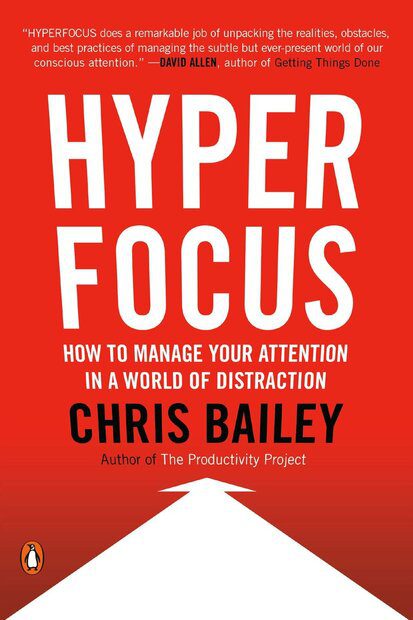Keep one important, complex object of attention in your awareness as you work.
In Hyperfocus: How to Be More Productive in a World of Distraction, Canadian writer and productivity consultant Chris Bailey describes strategies for maintaining and controlling focus, determining priorities, and minimizing interruptions in order to increase productivity.
Hyperfocus
You enter this mode by managing your attention deliberately and purposefully: by choosing one important object of attention, eliminating distractions that will inevitably arise as you work, and then focusing on just that one task. Hyperfocus is many things at once: it’s deliberate, undistracted, and quick to refocus, and it leads us to become completely immersed in our work. It also makes us immensely happy.
Hyperfocus means you’re less busy, because you’re permitting fewer objects into your attentional space.
When it comes to your most important tasks, the fewer things you pay attention to, the more productive you become. The most important aspect of hyperfocus is that only one productive or meaningful task consumes your attentional space.
THE FOUR STAGES OF HYPERFOCUS
“In any given moment you’re focused on either your external environment, the thoughts in your head, or both. Engaging solely with your external environment means you’re effectively living on autopilot. You slip into this mode as you wait for the traffic light to change or find yourself bouncing around a loop of the same apps on your phone. When you’re engaged only with the thoughts in your head, you’re daydreaming.
To hyperfocus, you must:
- Choose a productive or meaningful object of attention;
- Eliminate as many external and internal distractions as you can;
- Focus on that chosen object of attention; and
- Continually draw your focus back to that one object of attention.
Choose a productive or meaningful object of attention
Setting an intention for what we plan to focus on is the most important step—the more productive and meaningful the task, the more productive and meaningful your actions become.
We experience the benefits of hyperfocus mode by setting such simple intentions as being present in a conversation with our partner or fully enjoying a meal with our family. We learn more, remember more, and process our actions more deeply—and our lives become more meaningful as a result. This first step to reaching hyperfocus mode is essential—intention absolutely has to precede attention.
Eliminate as many external and internal distractions as you can
The second step to reaching hyperfocus is eliminating as many internal and external distractions as possible. There’s a simple reason we fall victim to distraction: in the moment, distractions are more attractive objects of attention than what we really ought to be doing. This is true both at work and at home. Email alerts that pop into the corner of our screen are usually more tempting than the task we’re doing in another window; the TV behind our partner at the pub is usually more enticing than focusing on the conversation.”
Distractions are infinitely easier to deal with in advance—by the time they appear, it’s often already too late to defend our intention against them.
Focus on that chosen object of attention
Third, hyperfocus becomes possible when we focus on our chosen object of attention for a predetermined amount of time. This involves hunkering down for a set period that is both comfortable and feasible. The more groundwork we lay in the first two steps of hyperfocus, the more deeply and confidently we can accomplish step three.
Continually draw your focus back to that one object of attention.
Fourth, and finally, hyperfocus is about drawing our attention back to the original object of attention when our mind wanders.
Research shows that our mind wanders for 47 percent of the day.
Choosing What to Focus On
Attention without intention is wasted energy. Intention should always precede attention—in fact, the two ideas pair perfectly. Intention setting allows us to decide how we should spend our time; focusing our attention on that task gets it done efficiently. The best way to become more productive is to choose what you want to accomplish before you begin working.
Autopilot Mode
The environments in which we live and work, unfortunately, have their own agenda for claiming our attention, bombarding us with alerts, notifications, beeps, and buzzes. This steady stream of interruptions prevents us from diving into any one thing properly; after all, it isn’t long before we’re presented with another email that feels just as urgent.
Core Theme – Keep one important, complex object of attention in your awareness as you work.
THE FOUR TYPES OF TASKS
Deciding where to direct our attention presents a similar fork in the road—only the pathways lead to the innumerable things on which we can choose to focus.
The most urgent and stimulating things in your environment are rarely the most significant. This is why switching off autopilot mode is so critical. Directing your attention toward the most important object of your choosing—and then sustaining that attention—is the most consequential decision we will make throughout the day. We are what we pay attention to.
There are two main criteria to consider when categorizing what to focus on: whether a task is productive (you accomplish a lot by doing it) and whether a task is attractive (fun to do) or unattractive (boring, frustrating, difficult, etc.).
Necessary work
Necessary work includes tasks that are unattractive yet productive. Team meetings and calls about your quarterly budget fall into this quadrant. We usually have to push ourselves to do this type of work.
Unnecessary work
Unnecessary work includes the tasks that are both unproductive and unattractive— like rearranging the papers on your desk or the files on your computer. We usually don’t bother with these tasks unless we’re procrastinating on doing something else or resisting a task that falls into the necessary work or purposeful work categories.
Spending time on unnecessary work tasks keeps us busy, but such busyness is just an active form of laziness when it doesn’t lead to actually accomplishing anything.
Distracting work
Distracting work includes stimulating, unproductive tasks and as such is a black hole for productivity. It includes social media, most IM conversations, news websites, watercooler chats, and every other form of low-return distraction. These activities can be fun but should generally be indulged in small doses. The better you become at managing your attention, the less time you’ll spend in this quadrant.
Purposeful work
Purposeful work—the productivity sweet spot. These are the tasks we’re put on earth to do; the tasks we’re most engaged in as we do them; the tasks with which we make the largest impact. Doing good work in this category usually requires more brainpower, and we are often better at these types of tasks than other people are.
Without selective interest, experience is utter chaos. —William James
Attentional Space
The amount of mental capacity we have available to focus on and process things in the moment. Our attentional space is what we’re aware of at any given time—it’s the scratch pad or clipboard in our brain that we use to temporarily store information as it’s being processed. Attentional space allows to us hold, manipulate, and connect information simultaneously, and on the fly.
When we choose what to pay attention to, that information occupies our short-term memory, and our attentional space ensures it’s kept active so we can continue to work with it. Together, our focus and attentional space are responsible for most of our conscious experiences.
Meta Awareness
Becoming aware of what you’re thinking about is one of the best practices for managing your attention. The more you notice what’s occupying your attentional space, the faster you can get back on track when your mind begins to wander, which it does a remarkable 47 percent of the time.
All thoughts want to be taken seriously, but few warrant it. – David Cain
On Productivity
Being busy doesn’t make us productive. It doesn’t matter how busy we are if that busyness doesn’t lead us to accomplish anything of importance. Productivity is not about cramming more into our days but about doing the right thing in each moment.
Productivity means accomplishing what we intend to.
Attention shifting vs Multi tasking
Multitasking means concurrently trying to focus on more than one thing at a time. Shifting our attention is the movement of our attentional spotlight (or our attentional space) from one task to another.
When we make our attentional space juggle too many tasks, we fail to notice and remember the details of our most important work. When we multitask, we even process our work with an entirely different part of our brain.
The Rule of 3
At the start of each day, choose the three things you want to have accomplished by day’s end. While a to-do list is useful to capture the minutiae of the day, these three intention slots should be reserved for your most important daily tasks.
All the Best in your quest to get Better. Don’t Settle: Live with Passion.



Comments are closed.